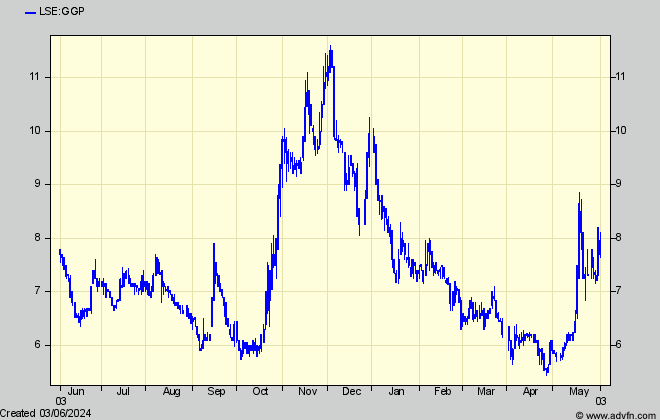Signs Of Life Or Another Mirage?

Gold’s strength seems to be a symptom of something. But of what? Impending collapse of the world’s financial system and replacement with a Gold Standard? China’s plot to supplant the dollar? Or merely anticipation of lower interest rates (still uncertain).
I’ve no idea – like many others I suspect. Certainly a link with gold wouldn’t allow Governments their current freedom to print money, so doesn’t look likely.
But what gold doesn’t yet seem to be predicting is any solid resurgence in industrial commodities. Yes, copper has been strong. But pundits think it’s a temporary reflection of a technical, arbitrage, position in the markets and inventories, together with China’s attempt to revive its property build industry which used to account for nearly 50% of all world copper usage. Nickel too has been strong – but only a blip in the long term (not very strong) recovery from the 2008 commodities crash.
If you factor in inflation, and the – said to be – 30% increase in mining costs and inflation in only the last few years, to get them out of the ground commodity prices are still well below what is needed to get new mines built.
I reckon Copper needs to be at least $13,000/tonne (currently $10,800 – up from $8,340 so far this year) to kick start any of the new mines needed to fulfil the so-called looming supply gap in the coming decade.
Hedge fund manager Pierre Andurand – formerly of Goldman Sachs – has recently said however, “I think we could end up to $40,000 per tonne copper over the next four years or so. I’m not saying it will stay there; eventually we will get a supply response, but that supply response will take more than five years.”
So he says it will be a blip – and meanwhile Goldman Sachs is more cautious, expecting only$9,900/tonne by 2028.
Even if copper spikes above that, banks won’t put up development funding until they are rock sure higher prices are guaranteed for the much longer term. So I can’t see much change yet for would-be copper miners’ prospects. The same is true for gold miners too.
In any case, how big will any copper supply gap be? Greening and especially transport was to be the great white hope. But Lithium is still bumping along the bottom, despite pundits’ hopes it would have started a recovery by now. It’s obvious that electric vehicle uptake, at least in the West, isn’t meeting expectations, and that will impact copper demand.
Even so, as one of the largest undeveloped copper (and almost as much gold) resources still out of the hands of the majors, the spotlight must still be on Solgold’s Cascabel project where I said something has to give, so the shares are up from 6p to 9.5p in three months. But they look stuck now as the interest the company says is being shown in acquiring or financing Cascabel grinds on. While the original block on the project – too high a capital cost and a shorter economic life than the 30 years the majors expect for a ‘tier one’ mine – has been partly remedied with a revised plan, there are still worries about the Ecuador central and local Government’s commitment to it. They would be foolish to turn down the economic benefits.
Gold miners are doing well of course, if they’re in production. Pan African Resources (PAF) is up 55% since January and broken out from its previous gentler uptrend. Hummingbird(HUM) has shaken off the willies after its contract miner resumed the work it stopped in March on the new Kouroussa mine, which is slated to double HUM’s gold production by the end of the year. And ASX:Barton Gold is at last in a persuasive uptrend in anticipation of a scoping study on its new Tunkillia 1.5Moz deposit, and encouraging drill results below and beyond its historic Tarcoola Perseverance high grade, open pit. It is well cashed up for this year’s drilling programme and could easily resume production at Tarcoola if not for prioritising even wider drilling.

HUM remains my top medium term pick despite its likely volatility as weather and other issues inevitably come and go. And BGD is my second.
Of the other goldies, I hardly dare mention again Kefi Gold and Copper. It is now 99% ready to start its Tulu Kepi gold project later this year, but it will be three years before cash flow well above its current market cap starts to show, which can be the only reason the shares aren’t anticipating it yet.
If gold is to continue strong, gold oriented streamers might be thought to be the ones to go for.
Perhaps I should say ‘were’, because granddaddy Wheaton Precious Metals (WPM) is currently forecast by Edison to be on a prospective PER over 50x after a 50% rise in the shares since February, on forecasts of less than 15% eps growth this year. So they might be due a relapse.
Against WPM, Pan African Resources (PAF) is 100% gold oriented and, on Edison’s forecasts, on a two year PER only around 1/10th of WPM’s, on forecast of 70% plus earnings growth.
Its location in strike prone South Africa, and in the middle of capital spending which will keep dividends relatively low for the time-being, seems the only reason the shares are lowly rated. But they are, surely, very cheap.
Gold is helping Trident Resources (TRR) too, as a new stream kicks in, promising to turn profits blue this year for the first time. But not definitely enough yet, pending income from the transformative Thaker Pass lithium stream which is still a few years away. I said the shares would take time and think that’s still true.
But what about that old elephant in the room, Greatland Gold (GGP) (with almost as much copper as gold, at its part-owned Western Australia Havieron project, whose shares are still becalmed except for the odd spasm. The reason is not discussed on the only source of ‘opinion’ (you can’t call it ‘research’) for retail investors – namely the chat board run by its public relations firm in disguise – which dissuades any discussion of the major question – how GGP will fund any attempt to ‘buy’ from Newmont the 70% of Havieron it doesn’t own – and then how to fund the mine itself. While its economics looked very compelling, observers are waiting for a new feasibility study which will update the considerable changes since the last one, where major cost rises and an expanded mining plan renders it impossible to guess what it will show.
That is not the only reason for standing well back from the shares. De Grey Mining’s similar sized Hemi project three hundred miles away has just had to raise over A$600m (despite an already healthy balance sheet) as a 40% contribution to Hemi’s capex before lenders will lend the rest, and GGP’s balance sheet is far more flimsy than De Grey’s. No matter how ‘attractive’ a project might look, lenders always want a substantial risk equity component to any funding structure and GGP has practically none at present. If equity partners come in instead, they will cause the same dilution for current shareholders by a different route. Substantial dilution for them seems inevitable.

As for UK broker share price forecasts, Cannacord and Berenberg differ widely, (the highest, 20p, labelled ‘speculative’) – too right cobber ! Both use the illogical and financially illiterate ‘target’ price methodology based on NPV’s – ie the discounted present value of all future cash inflows – as if a sensible investor would pay upfront for them. Its why they are never remotely reached in practice, but they help a company’ s broker flog the shares. Remember the notorious Sirius Minerals failed attempt to raise development funding where the broker totted up future income 55 years ahead and pretended that should be the raise price. The institutions laughed him out of sight, and Sirius out of existence.
Elsewhere, even some of the would-be green suppliers I covered (not very enthusiastically) in March are poking their heads up.
Despite the failed prediction that lithium would have rebounded by now, by the CEO of Atlantic Lithium’s 50% partner in its planned Ewoyaa mine, Atlantic Resources (ALL) has perked up on predicted news flow, including a listing on the Ghana stock exchange and a pending offtake agreement for the last 50% of its output. With Ghana government support, all looks clear for the mine to start, but I remain cautious until the offtake terms allow a proper calculation of the return to the top company shareholders.
I said Armadale’s (ACP) Tanzanian graphite project looked the best short term punt of the greenies, due to its ‘promise’ to minimise dilution for shareholders, but it seems I was wrong.
In the absence of funding for its Mahenge project, ACP has turned to depending on its recent acquisition of the Canyon Silver Project in Idaho for cash flow to help develop it. Although it’s confident enough to resume the necessary engineering studies at Mahenge, the project is still too speculative for investors, given the time it will take.
Even so, graphite is forecast to be the one bulk green commodity to show the greatest price increase, which is why I mentioned in passing ACP’s Mahenge four times larger neighbour, Australian Black Rock Mining (ASX:BKT) which appears near to full funding for its mine. However it won’t deliver for at least five years, and despite heavyweight backing is also too far away to merit an investment yet.
As for the rest, Pensana (PRE) despite lack of investor interest, is, like Atlantic Lithium, pressing on with its Angola rare earths mine. Lack of interest might be due to the absence of detailed financial projections, and is despite recent backing from heavyweight African financial institutions for at least the mine. What remains obscure are numbers for the associated Teeside ore processing plant, although it, too, seem to be attracting UK government support. Detailed figures might one day allow a better evaluation of what could be a highly profitable scheme.
Comments (0)